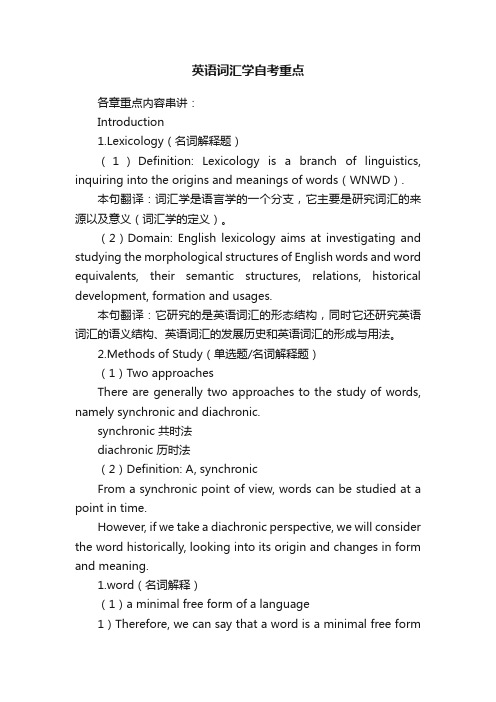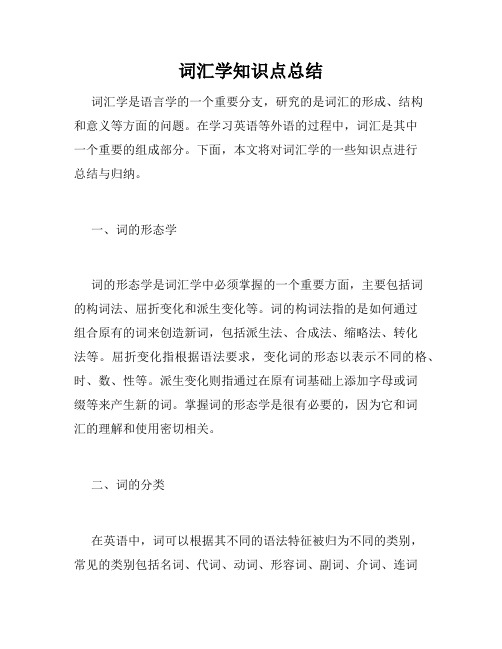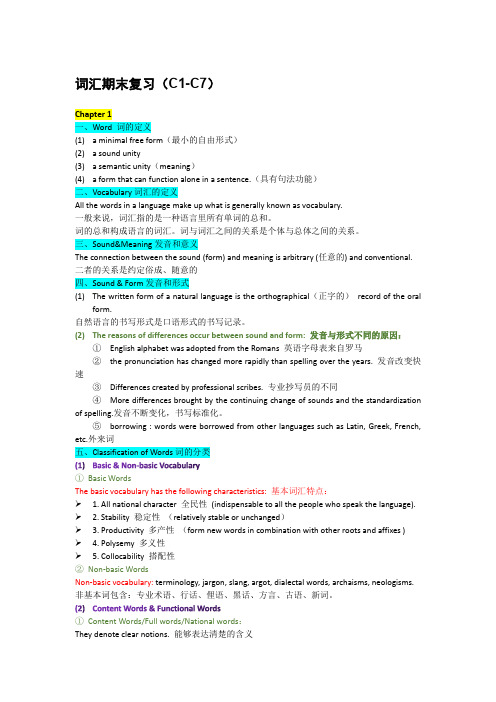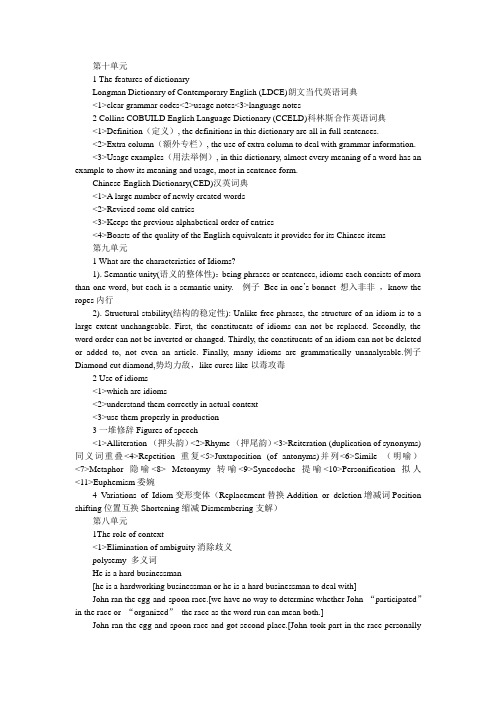词汇学复习重点(精心挑选整理过的)
英语词汇重点归纳总结

英语词汇重点归纳总结英语词汇是学习英语的基础,掌握各类词汇的意思和用法对于提高英语能力至关重要。
本文将对英语词汇的重点进行归纳总结,帮助读者更好地掌握和记忆这些词汇。
一、名词 (Noun)名词是指人、物、地点或抽象概念。
它通常作为句子的主语、宾语或补语。
1. 人物名词 (Personal Nouns)人物名词指人的名称,如:- 男性人名:John, Michael, David- 女性人名:Emily, Jessica, Sarah- 姓氏:Smith, Johnson, Wang2. 物体名词 (Concrete Nouns)物体名词指具体物体的名称,如:- 动物:dog, cat, bird- 植物:tree, flower, grass- 食物:apple, bread, rice3. 抽象名词 (Abstract Nouns)抽象名词指无法触摸的事物或抽象概念的名称,如:- 爱情:love- 自由:freedom- 成功:success二、动词 (Verb)动词是表示行为、状态或存在的词汇,它们表达句子中的核心意义。
1. 行为动词 (Action Verbs)行为动词指表示一个具体行为的词,如:- 跑:run- 吃:eat- 睡觉:sleep2. 状态动词 (State Verbs)状态动词指表示状态或感觉的词,如:- 是:be- 有:have- 感到:feel3. 助动词 (Auxiliary Verbs)助动词用于帮助主要动词构成不同的时态和语态,如:- be, do, have三、形容词 (Adjective)形容词用来描述名词的特征或性质,使句子更加生动有趣。
1. 形容人的特征 (Describing People)- 聪明的:smart- 友好的:friendly- 漂亮的:beautiful2. 形容物体的特征 (Describing Objects)- 大的:big- 红的:red- 甜的:sweet3. 形容情感和感觉 (Describing Emotions and Feelings)- 快乐的:happy- 紧张的:nervous- 平静的:calm四、副词 (Adverb)副词用来修饰动词、形容词或其他副词,表示程度、方式、时间等。
英语词汇学自考重点

各章重点内容串讲:Introduction1.Lexicology(名词解释题)(1)Definition: Lexicology is a branch of linguistics, inquiring into the origins and meanings of words(WNWD).本句翻译:词汇学是语言学的一个分支,它主要是研究词汇的来源以及意义(词汇学的定义)。
(2)Domain: English lexicology aims at investigating and studying the morphological structures of English words and word equivalents, their semantic structures, relations, historical development, formation and usages.本句翻译:它研究的是英语词汇的形态结构,同时它还研究英语词汇的语义结构、英语词汇的发展历史和英语词汇的形成与用法。
2.Methods of Study(单选题/名词解释题)(1)Two approachesThere are generally two approaches to the study of words, namely synchronic and diachronic.synchronic 共时法diachronic 历时法(2)Definition: A, synchronicFrom a synchronic point of view, words can be studied at a point in time.However, if we take a diachronic perspective, we will consider the word historically, looking into its origin and changes in form and meaning.1.word(名词解释)(1)a minimal free form of a language1)Therefore, we can say that a word is a minimal free form of a language(词是语言中的最小的自由形式)2)that has a given sound and meaning and syntactic function.(词有固定的读音,固定的意义,固定的句法功能。
词汇学复习范围

复习重点:第一章1. word的正规定义及简略定义;2. 词汇的定义的四部分;3. sound与meaning的关系;4. 书写发音不一只的五个原因。
第二章1. Roman Language family的五个成员,Germanic language family的八个成员;2. 英语语言发展的三个时期:1)时间跨度;2)事件;3)每个事件带来的语言;4)词汇涉及的语言领域;3. 对英语词汇奉献最大的是Latin语言;对英语语言影响(含语法和词汇影响)最大的是French。
第三章1. morpheme的正规定义级简略定义。
2. allomorph的定义3. free morpheme 和bound morpheme的正规定义和简略定义4. root, stem 和base 的定义及关系。
第四章1. 英语构词法的主要构词方式和次要构词方式;2. affixation的定义,分类及其分类的定义;3. compounding的定义及特点;4. shortening的种类;5. blending的定义;6. clipping的定义;7. acronymy的定义和种类及种类的定义;8. backformation的定义第五章1. reference,concept 和sense的定义;2. 词义的两部分的定义;3. 词汇意义的分类定义,下分类的定义;第六章1. polysemy 的定义2. homonymy的定义和分类级分类定义;3. synonymy的传统和现代定义和分类及分类的定义;4. antonymy的传统和现代定义和分类及分类的定义;。
英语词汇学自考重点

英语词汇学自考重点各章重点内容串讲:Introduction1.Lexicology(名词解释题)(1)Definition: Lexicology is a branch of linguistics, inquiring into the origins and meanings of words(WNWD).本句翻译:词汇学是语言学的一个分支,它主要是研究词汇的来源以及意义(词汇学的定义)。
(2)Domain: English lexicology aims at investigating and studying the morphological structures of English words and word equivalents, their semantic structures, relations, historical development, formation and usages.本句翻译:它研究的是英语词汇的形态结构,同时它还研究英语词汇的语义结构、英语词汇的发展历史和英语词汇的形成与用法。
2.Methods of Study(单选题/名词解释题)(1)Two approachesThere are generally two approaches to the study of words, namely synchronic and diachronic.synchronic 共时法diachronic 历时法(2)Definition: A, synchronicFrom a synchronic point of view, words can be studied at a point in time.However, if we take a diachronic perspective, we will consider the word historically, looking into its origin and changes in form and meaning.1.word(名词解释)(1)a minimal free form of a language1)Therefore, we can say that a word is a minimal free formof a language(词是语言中的最小的自由形式)2)that has a given sound and meaning and syntactic function.(词有固定的读音,固定的意义,固定的句法功能。
词汇学知识点总结

词汇学知识点总结词汇学是语言学的一个重要分支,研究的是词汇的形成、结构和意义等方面的问题。
在学习英语等外语的过程中,词汇是其中一个重要的组成部分。
下面,本文将对词汇学的一些知识点进行总结与归纳。
一、词的形态学词的形态学是词汇学中必须掌握的一个重要方面,主要包括词的构词法、屈折变化和派生变化等。
词的构词法指的是如何通过组合原有的词来创造新词,包括派生法、合成法、缩略法、转化法等。
屈折变化指根据语法要求,变化词的形态以表示不同的格、时、数、性等。
派生变化则指通过在原有词基础上添加字母或词缀等来产生新的词。
掌握词的形态学是很有必要的,因为它和词汇的理解和使用密切相关。
二、词的分类在英语中,词可以根据其不同的语法特征被归为不同的类别,常见的类别包括名词、代词、动词、形容词、副词、介词、连词和感叹词等。
不同的词在句子中扮演着不同的角色,掌握各类别之间的区别以及它们在句子中的作用,可以帮助我们更好地理解和表达语言。
三、词义词义是从语言学的角度定义词的意义,包括原义和引申义。
原义指的是一个词最基本的意思,而引申义则是在原义基础上经过延伸、扩展而得到的新意义。
同一个词的不同意义和语言环境等也会导致其含义的变化,例如“bank”既可以表示银行,也可以表示河岸等。
在学习外语的过程中,掌握词义是十分重要的。
四、词汇的学习方法词汇的学习是英语学习中最基础也最重要的部分之一,因此选择适合自己的学习方法对于提高词汇量、扩大词汇面积至关重要。
常用的学习方法包括反复背诵、积累单词簿、整理词根词缀、阅读和听力等。
在学习方法上,以选择适合自己和有用的方法为主,同时注意与语言运用的联系,不断地推广和实践。
五、词汇的应用掌握了词汇学的知识和学习方法后,其实就迈出了学习英语的第一步。
在实际运用中,如何运用得当也是至关重要的环节。
为了提高语言的流利度,需要在口语和书面语两个方面加强实践,增强实际运用能力。
另外,可以较晚多在社交网络等平台上与外国人联系,使用所学的词汇,将知识应用到实际交流之中,效果更佳。
英语词汇学知识点整理

词汇期末复习(C1-C7)Chapter 1一、Word 词的定义(1) a minimal free form(最小的自由形式)(2) a sound unity(3) a semantic unity(meaning)(4) a form that can function alone in a sentence.(具有句法功能)二、Vocabulary词汇的定义All the words in a language make up what is generally known as vocabulary.一般来说,词汇指的是一种语言里所有单词的总和。
词的总和构成语言的词汇。
词与词汇之间的关系是个体与总体之间的关系。
三、Sound&Meaning发音和意义The connection between the sound (form) and meaning is arbitrary (任意的) and conventional. 二者的关系是约定俗成、随意的四、Sound & Form发音和形式(1)The written form of a natural language is the orthographical(正字的)record of the oralform.自然语言的书写形式是口语形式的书写记录。
(2)The reasons of differences occur between sound and form: 发音与形式不同的原因:①English alphabet was adopted from the Romans 英语字母表来自罗马②the pronunciation has changed more rapidly than spelling over the years. 发音改变快速③Differences created by professional scribes. 专业抄写员的不同④More differences brought by the continuing change of sounds and the standardization of spelling.发音不断变化,书写标准化。
词汇学知识点总结

词汇学知识点总结词汇学是研究词汇的学科,它是语言学的一个重要分支,涉及了语言的构成、变化和使用等方面。
词汇学对于语言的理解和应用具有重要的意义,它不仅可以帮助我们更好地掌握语言知识,还可以帮助我们提高语言运用能力。
在这篇文章中,我们将对词汇学的知识点进行总结,帮助读者更好地理解和掌握这一学科。
一、词的定义和分类词是语言中的最小意义单位,是构成句子和表达意思的基本单位。
按照在句子中的功能和语法特征,词可以分为实词和虚词两大类。
实词包括名词、动词、形容词、副词等,它们能够表示具体的事物或抽象的概念;虚词包括代词、连词、介词、助词等,它们通常用来连接或修饰实词,没有明确的词义。
二、词汇的构成词汇的构成是指词的组成方式和形态特征。
在词汇的构成中,我们可以看到一些常见的构词法,如前缀、后缀、派生、合成、转化等。
通过这些构词法,我们可以对词汇进行灵活组合和创造,丰富语言的表达能力。
1.前缀前缀是指加在词根前面的一个字,可以改变词的词义或语法特征。
比如,“un-”表示否定,“re-”表示再次,“pre-”表示在前面等。
2.后缀后缀是指加在词根后面的一个字,同样可以改变词的词义或语法特征。
比如,“-ing”表示进行时,“-ful”表示充满的意思,“-ment”表示名词化等。
3.派生派生是指通过词根和词缀的组合来创造和衍生新的词。
比如,“happy”是一个形容词,通过加上“-ness”后缀就可以派生出名词“happiness”。
4.合成合成是指两个或多个词汇组合在一起,形成一个新的词。
比如,“blackboard”由“black”和“board”两个实词组合而成。
5.转化转化是指一个词汇的词类发生改变,但词形不变。
比如,“work”可以作为动词,也可以作为名词,它的词形都不发生变化。
词汇的构成方式是多种多样的,通过学习这些构词法,我们可以更好地理解和掌握词汇的形态特征,有助于提高我们的语言表达能力。
三、词汇的语义特征语义是指词汇所携带的意义,它是语言交流和理解的基础。
词汇学期末考试重点整理

第十单元1 The features of dictionaryLongman Dictionary of Contemporary English (LDCE)朗文当代英语词典<1>clear grammar codes<2>usage notes<3>language notes2 Collins COBUILD English Language Dictionary (CCELD)科林斯合作英语词典<1>Definition(定义), the definitions in this dictionary are all in full sentences.<2>Extra column(额外专栏), the use of extra column to deal with grammar information.<3>Usage examples(用法举例), in this dictionary, almost every meaning of a word has an example to show its meaning and usage, most in sentence form.Chinese-English Dictionary(CED)汉英词典<1>A large number of newly created words<2>Revised some old entries<3>Keeps the previous alphabetical order of entries<4>Boasts of the quality of the English equivalents it provides for its Chinese items第九单元1 What are the characteristics of Idioms?1). Semantic unity(语义的整体性):being phrases or sentences, idioms each consists of mora than one word, but each is a semantic unity. 例子Bee in one’s bonnet 想入非非,know the ropes内行2). Structural stability(结构的稳定性): Unlike free phrases, the structure of an idiom is to a large extent unchangeable. First, the constituents of idioms can not be replaced. Secondly, the word order can not be inverted or changed. Thirdly, the constituents of an idiom can not be deleted or added to, not even an article. Finally, many idioms are grammatically unanalysable.例子Diamond cut diamond,势均力敌,like cures like以毒攻毒2 Use of idioms<1>which are idioms<2>understand them correctly in actual context<3>use them properly in production3一堆修辞Figures of speech<1>Alliteration (押头韵)<2>Rhyme (押尾韵)<3>Reiteration (duplication of synonyms)同义词重叠<4>Repetition重复<5>Juxtaposition (of antonyms)并列<6>Simile (明喻)<7>Metaphor 隐喻<8> Metonymy转喻<9>Synecdoche提喻<10>Personification拟人<11>Euphemism委婉4 Variations of Idiom变形变体(Replacement替换Addition or deletion增减词Position shifting位置互换Shortening缩减Dismembering支解)第八单元1The role of context<1>Elimination of ambiguity消除歧义polysemy 多义词He is a hard businessman[he is a hardworking businessman or he is a hard businessman to deal with]John ran the egg-and-spoon race.[we have no way to determine whether John “participated”in the race or “organized”the race as the word run can mean both.]John ran the egg-and-spoon race and got second place.[John took part in the race personallybecause he got second place.]Homonymy同型同音异义They saw her duck.[duck—n. “a kind of poultry”or as a verb meaning “lower one’s head or body quickly, dodge (忽地低下头(或弯腰),躲避).Both fit in the syntactic structure of the sentence .]The ball was attractive.[ ball may mean a “a round object to play in a game”as well as a “dancing party”. ]The fish is ready to eat[the fish is cooked or served, so ready for people to eat.or the fish is ready to eat things.]I like mary better than jean[ i like mary better than i like jean.or i like mary better jean likes mary.]<2>Indication of referents限定所指<3> Provision of clues for inference of word meaning提供线索【P157】2如何为理据提供线索Definition下定义Explanation解释Exemplification 例证Synonymy同义Antonymy反义词Hyponymy上下关系Relevant details相关细节Word structure课后题【P160,3】第七单元1Types of Changesextension词义的扩大, narrowing词义的缩小,degradation降格, elevation升华, and transfer转移.2Causes of ChangesLinguistic Factors (语言因素)and Extra-linguistic Factors(非语言因素)第六单元1 Two Approaches to Polysemy一词多义Diachronic (历时的)Synchronically(共时地)2 Two Processes of DevelopmentRadiation(辐射型)Concatenation(连锁型)3Types of Homonymsperfect homonyms , homographs拼写同and homophones音同Homophones constitute the largest number and are most common4Origins of Homonyms<1>Change in sound and spelling long a not short , from lang. long to want very much , from langian <2>borrow ing fair a market . Borrowed from feria .fair pretty , from fæger <3>shortening ad shortened from advertisement add to cause an increase5. Try to point out the main sources of synonyms(同义词).1). Borrowing. The most important source is perhaps borrowing.2). Dialects and regional English.3). Figurative and euphemistic use of words.4). Coincidence with idiomatic expressions.6. What’s the fundamental difference between the processes of radiation(辐射型)and concatenation(连锁型)? Illustrate your point.答:Radiation describes a process where each of the derived meaning is directly connected tothe primary meaning, concatenation describs a process where each of the later meaning is related only to the preceding one like chains. But the two are closely related , being different stages of the development leading to polysemy. Generally, radiation precedes concatenation. In many cases, the two processes work together, complementing each other.7. Try to illustrate the three major types of Antonyms with examples.答:1). Contradictory terms(矛盾反义词). These antonyms truly represent oppositeness of meaning. They are so opposed to each other that they are mutually exclusive and admit no possibility between them. The assertion of one is the denial of the other. In other words, if one of the pair is true, then the other cannot be. For example: dead and alive; boy and girl; present and absent. Another character of this category is that such antonyms are non-gradable.2). Contrary terms(对立反义词). Antonyms of this type are best viewed in terms of a scale running between two poles or extremes. Antonyms such as: rich and poor; old and young; big and small represesnt two points at both ends of the pole. The two opposites are gradable and one exists in comparison with the other.3). Relative terms(关系反义词). This third type consists of relational opposites such as: parent and child; husband and wife; employer and employee. The pairs of words indicate such a reciprocal social relationship that one of them can not be used without suggesting the other.8What’s polysemy?Polysemy(多义关系)is a common feature peculiar to all natural Languages.9.How do you understander the statement that “true synonymy is non-existent.Synonyms can be classified into absolute synonyms(绝对同义词) and relative synonyms(相对同义词)they are confined to technical terms like word formation-word building but even technical terms like these might still have some slight difference, for instance, one term mat be more used than the other or one term is preferable in some situation. That is why we say “true synonymy is non-existent.10.homonymy(同形同音异义关系): Homonyms are generally defined as words different in meaning but either identical both in sound and spelling or identical only in sound or spelling.11. a men changes his habits, alters his conduct, and varies his manner of speaking.I did not comprehend his arguments, although i understood the language, and all the sentences.[p111 108 两个图]The most important source of synonyms is perhaps borrowing.The use of antonymsDefining the meanings of the words and express economically the opposite of a particular thought.第五单元Reference(所指关系) is the relationship between Language and the world.concept(概念): Concept, which is beyond Language, is the result of human cognition, reflecting the objective world in the human mind. It’s universal to all men alike regardless of culture, race, Language and so on.2. sense(语义): Sense denotes the relationship inside the Language. The sense of an expression is its place in a system of semantic relationships with other expressions in the Language.3. motivation(理据): Motivation accounts for the connection between the linguistic symboland its meaning.第四单元1.Affixation,derivation(词缀法): [prefixation前缀法suffixation后缀法]pounding(合成法)3conversion(转换法)4 blending(拼缀法)5clipping(截短法)6 acronymy(首字母拼音法):7initialisms(首字母缩略词)8 acronyms(首字母拼音词):9back-formation(逆生法)课后题1. What are the differences between root and stem?答:①A root is the basic form of a word which can not be further analysed without total loss of identity. The root whether free or bound generally carries the main component of meaning in a word.② A stem may consist of a single root morpheme as in “iron”or of two root morphemes as in a compound like “handcuff”. It can be a root morpheme plus one or more affixational morphemes as in “mouthful”. Therefore, a stem can be defined as a form to which affixes of any kind cab be added.第二单元1Mode of vocabulary developmentModern English vocabulary develops through three channels: creation, semantic change, borrowing CRATION: Creation refers to the formation of new words by using the existing materials , namely roots affixes and other elements Semantic change means an old form which takes on a new meaning to meet the new need. Words taken over from foreign languages are known as borrowing.2词的发展1,Old English[450-1150] Middle English[1150-1500] Modern Englis[1500-up to now]第一单元一、BASIC CONCEPTS OF WORD AND VOCABULARY 1、the definition of a word comprises : A, a minimal free form of a language B, a sound unity C, a unit of meaning D, a form that can function alone in a sentence 2, classification of word 词的分类:words may falls into the basic word stock and nonbasic vocabulary by use frequency, into content words and functional words by notion, and into native words and borrowed words by origin 3, BASIC WORD STOCK 的特点A, all national character B, stability C, productivity D, polysemy多义性E, collocability 搭配性4,没有3的特点:A, Terminology术语B, Jargon行话C, Slang谚语习语D, Argot黑话E, Dialectal words方言F, Archaisms古语G, Neologisms新词5, Content word/ notional word 实词functional words /empty words虚词6,Native word特点:A, all national character B, stability C, productivity D, polysemy多义性E, collocability 搭配性F, neutral in style风格性G, frequent in use频繁使用7,according to the degree of assimilation 同化and manner of borrowing,外来词的四种类型:Denizens本土化Aliens异化词Translation-loans译借词Semantic-loans借义词课后题1,A Borrowed words which still sound foreign and look foreign are [aliens]. B There is no [logical]relationship between sound and [meaning]as the connection between them is [arbitrary]and conventional. C[Denizens] borrowings that have become naturalized D Archaisms are words no longer in [common] use [obsolete] E content words are changing all the time whereas functional words are [stable] [functional] [higher] F a word whose meaning was borrowed [semantic loan]。
- 1、下载文档前请自行甄别文档内容的完整性,平台不提供额外的编辑、内容补充、找答案等附加服务。
- 2、"仅部分预览"的文档,不可在线预览部分如存在完整性等问题,可反馈申请退款(可完整预览的文档不适用该条件!)。
- 3、如文档侵犯您的权益,请联系客服反馈,我们会尽快为您处理(人工客服工作时间:9:00-18:30)。
Motivation of words分类:onomatopoeic motivation, morphological motivation, semantic motivation, etymological motivation. Types of meaning: grammatical ~ & lexical ~; conceptual ~& associative ~(connotative~, stylistic~, affective ~, collocative ~,)Primary meaning is the only meaning that a word had when it was first created. Derived meanings are the meanings that a word gets from the primary meaning at different stages of its development in the course of time.同义关系Synonyms are words which share the same or nearly the same meaning with each other but different in sound and spelling. There are absolute synonyms and relative synonyms which result from borrowing, dialects and regional English, figurative and euphemistic use of words, coincidence with idiomatic expressions. There exists the difference between or among synonyms in terms of their denotation, connotation or application. Absolute synonyms or complete synonyms are words which are identical in meaning in all its aspects. Relative synonyms or near-synonyms are similar or nearly the same in denotation, but embrace different shades of meaning or different degrees of a given quality.3.Sources of Synonyms 1) Borrowing 2)Dialects and regional English 3) Figurative and euphemistic use of words 4) Coincidence with idiomatic expressions4.What are the characteristics of antonyms?1) Antonyms are classified on the basis of semantic opposition 2) A word which has more than one meaning can have more than one antonym. 3) Antonyms differ in semantic inclusion. 4) Contrary terms are gradable antonyms, differing in degree of intenisty, so each has its own corresponding opposite.5.同形同音异义关系Homonymy is one of the features of words that a word is different in meaning from another, but either identical both in sound and spelling or identical only in sound or spelling with the other Homonyms generally fall into three classes: perfect homonyms (same name); homographs (same spelling) and homophones (some sound). Perfect homonyms are those words identical both in sound and spelling, but different in meaning. Homophones refer to the words identical only in sound but different in spelling and meaning6.上下义关系:Hyponymy deals with the relationship of semantic inclusion. That is, the meaning of a more specific word is included in that of another more general word. Superordinates refer to some general words; subordinates denote those more specific words. Hyponymy can be described in terms of tree-like graphs, with higher-order superordinates above the lower subordinates. But their status either as superordinate or subordinate is relative to other terms. For example, horse, dog, pig are subordinates in relation to animal, but superordinates of mare, hound and boar, Animal itself becomesa subordinate of creature. And creature in turn becomes7.词义变化的种类There are five types of meaning, changes: extension, narrowing, degradation, elevation, and transfer among which extension and narrowing are the most common. Changes in meaning can be accounted for from extra-linguistic factors (historical reason, class reason, and psychological reason) and intra-linguistic factors (shortening, the influx of borrowing, and analogy).8.词义的扩大Extension is a process by which a word with a specialized sense is generalized to covera broader or less9.Definite concept. Compare the following;词义的缩小Narrowing is a process by which a word of wider meaning acquires a specialized sense;词义的升华Elevation is a process by which a word moves from a derogatory or neutral sense to a neutral and/or appreciative sense;词义的降格Degradation is a process by which a word of reputation slides into a pejorative use,;词义的转移Transfer is a process by which a word denoting one thing changes to refer to a different but related thing. Paper serves as an example. This word formerly denoted an African plant papyrus, which wasonce used to make paper. In modern times, paper is made from rags, wood, straw and the like, but the product has retained the same name. There is associated transfer. There are other kinds of transfer, such as, concrete to abstract, abstract to concrete and transfer of sensation.10.语境的种类:非语言语境。
语言语境:词汇语境和语法语境。
There are two types of contexts: linguistic context and extra-linguistic (or non-linguistic context). Extra-linguistic context refers to those situations and features which are not directly a part of the language in use but which either contribute in conveying a message or have an influence on language use. Linguistic or Intra-linguistic context is further subdivided into lexical context and grammatical context. By lexical context we mean the words that occur together with the word in question. By grammatical context we mean that the meanings of a word may be influenced by the structure in which it occurs.11.语境的作用:Three major functions of context: elimination of ambiguity, indication of referents, provision of clues for inferring word-meaning. Context an be summed up as follows:1) definition 2) explanation 3) example 4) synonymy 5) Antonymy 6)hyponymy 7) relevant details 8) word structure12.英语习语的特点The characteristics of idioms include semantic unity and structural stability.13.英语习语的分类According to the criterion of their grammatical functions, we classify them into idioms nominal in nature, idioms adjectival in nature, idioms verbal in nature, idioms adverbial in nature, and sentence idioms. The stylistic features are characterized with colloquialisms, slang, and literary expressions.14.英语习语的使用The use of idioms involves their stylistic features, rhetorical features , and variations of idioms.15.英语习语的修辞色彩The rhetorical features of idioms are represented with phonetic manipulation ( alliteration 头韵法and rhyme叠韵) , lexical manipulation ( reiteration复用, repetition重复and juxtaposition反义词叠用), figures of speech ( simile明喻, metaphor暗喻, metonymy转喻, synecdoche借代, personification拟人, euphemism委婉)16.英语习语的变异形式In the variations, addition, deletion, replacement, position-shifting and dismembering are involved in the changes in idioms constituents .17.Associative meaning : 1) associative meaning is the secondary meaning supplemented to the conceptual meaning. 2)It differs from the conceptual meaning in that it is open-ended and indeterminated. 3)It is liable to the influence of such factors as culture , experience, religion, geographical region, class background,education, etc. 4)Associative meaning comprises four types : connotative, stylistic, affective, and collocative.词典的种类There are four types of dictionaries with their features mentioned in this parts: (1) monolingual and bilingual dictionaries, (2) linguistic and encyclopedic dictionaries, (3) unabridged, desk and pocket dictionaries, (4) specialized dictionaries. A monolingual dictionary is a dictionary which is written in one language.18.A bilingual dictionary is one in which two languages are involved.19.A linguistic dictionary is a dictionary which aims at defining words and explaining their usages in the language.20. An encyclopedic dictionary is one in which encyclopedic information is provided along with the general information as in a linguistic dictionary.21.An encyclopedia is a dictionary which only provides encyclopedic information concerning each headword.22.An unabridged dictionary is an unshortened dictionary with at least 200,000 headwords that can supply a great quantity of basic, information about a word.23.A desk dictionary is a medium-sized dictionary containing words ranging from 50,000 to 150,000.24.A pocket dictionary is a dictionary which has about 50,000 entries or fewer.第一章37.What is word ?词具有哪些特点?词的特点也就是对词的名词解释。
